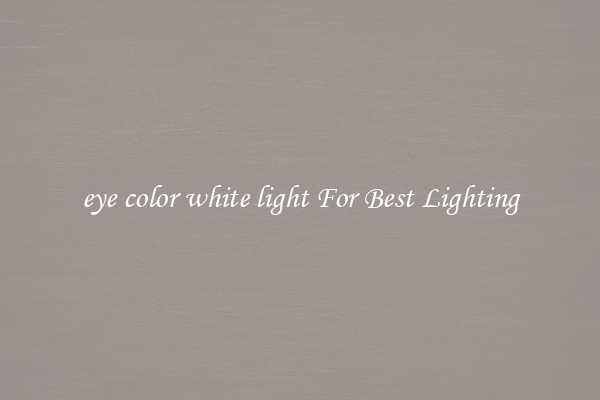eye color white light For Best Lighting
When it comes to lighting, many factors need to be considered to ensure the best lighting conditions. One important aspect that often goes unnoticed is the concept of eye color and white light. Believe it or not, the color of your eyes can play a significant role in determining the most favorable lighting for you.

White light, often referred to as daylight, is considered the best lighting source as it closely resembles natural sunlight. It consists of all the colors of the rainbow combined, providing a balanced and even illumination. However, the way white light interacts with different eye colors can vary.
People with dark-colored eyes, such as brown or black, have a higher concentration of melanin in their irises. Melanin is responsible for determining the color of our eyes as well as how they absorb and perceive light. Due to the higher pigment concentration, those with darker eyes typically require more light to achieve optimal visibility. White light proves to be highly effective in this case, as it provides a bright and intense illumination.
On the other hand, individuals with lighter eye colors, such as blue or green, have less melanin in their irises. Consequently, they tend to be more sensitive to light and require less illumination. White light can sometimes be too harsh for these individuals, causing discomfort and strain. In such cases, utilizing warmer tones of light, such as soft white or warm white, can be more soothing and create a comfortable ambiance.
It is important to understand that the lighting requirements for individuals with different eye colors can also vary depending on other factors. For instance, age, overall eye health, and the underlying purpose of the space being illuminated can influence the ideal lighting conditions.
To ensure optimal lighting regardless of eye color, modern lighting solutions offer adjustable color temperature options. Through the use of tunable LED lights, it is now possible to alter the color temperature of the white light emitted. This allows individuals to customize the lighting according to their specific needs and preferences, taking into account eye color and other relevant factors.
In conclusion, eye color can influence the ideal lighting conditions for individuals. While those with darker eyes benefit from the intensity of white light, individuals with lighter eye colors might find it more comfortable to use warmer tones of light. However, it is crucial to consider other factors such as age, eye health, and the purpose of the space being illuminated. With adjustable color temperature options available in modern lighting solutions, it has become easier to cater to individual lighting requirements for the best visual experience.

View details

View details

View details

View details








